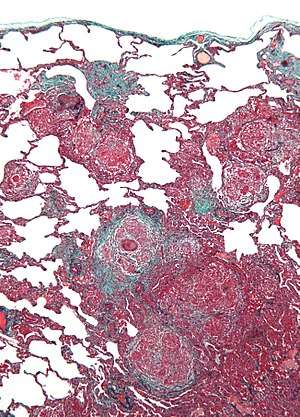Bird fancier's lung
Bird fancier's lung (BFL) is a type of hypersensitivity pneumonitis (HP). It is triggered by exposure to avian proteins present in the dry dust of the droppings and sometimes in the feathers of a variety of birds. The lungs become inflamed, with granuloma formation. Birds such as pigeons, parakeets, cockatiels, shell parakeets (budgerigars), parrots, turtle doves, turkeys and chickens have been implicated.
| Bird fancier's lung | |
|---|---|
| Other names | Bird-breeder's lung, pigeon-breeder's lung |
 | |
| Micrograph of hypersensitivity pneumonitis, the histologic correlate of bird fancier's lung. Lung biopsy. Trichrome stain. | |
| Specialty | Pulmonology |
People who work with birds or own many birds are at risk. Bird hobbyists and pet store workers may also be at risk.
Signs and symptoms
This disease is an inflammation of the alveoli in the lungs caused by an immune response to inhaled allergens from birds. Initial symptoms include shortness of breath (dyspnea), especially after sudden exertion or when exposed to temperature change, which can resemble asthma, hyperventilation syndrome or pulmonary embolism. Chills, fever, non-productive cough and chest discomfort may also occur. Upon re-exposure to avian proteins, sensitized individuals will typically experience symptoms within 4–6 hours or sooner. In the chronic form there is usually anorexia, weight loss, extreme fatigue and progressive pulmonary fibrosis, which is generally the most serious consequence of the disease because it irreversibly and increasingly diminishes the lungs' efficiency over time. As a result, sufferers may have repeated chest infections and ultimately struggle to breathe. This condition can eventually be fatal.[1]
Differential diagnosis
A definitive diagnosis can be difficult without invasive testing, but extensive exposure to birds combined with reduced diffusing capacity are strongly suggestive of this disease. X-ray or CT scans will show physical changes to the lung structure (a ground glass appearance) as the disease progresses. Precise distribution and types of tissue damage differ among similar diseases, as does response to treatment with Prednisone. There are two forms of BFL: acute and chronic. Diffuse alveolar damage (DAD) can occur with acute respiratory failure; progressive interstitial fibrosis is typical of the chronic form.[2] In both, the underlying inflammatory response stops upon exclusion of the allergen,[3] but symptoms may persist depending on the degree of damage already sustained. Among invasive procedures, bronchoalveolar lavage typically shows prominent lymphocytosis with an inverted CD4+/CD8+ ratio, and lung biopsy usually reveals non-necrotizing granulomatous inflammation.[4]
Treatment
Prednisone often suppresses symptoms temporarily, especially in the early stages of the disease, and by reducing inflammation it might also delay scarring (fibrosis) in the lungs. However, the only recommended long-term treatment is avoidance of the avian proteins that trigger BFL. Unless fibrosis has progressed beyond recovery, symptoms should improve, sometimes dramatically, in the absence of such allergens. Therefore, it is advisable to remove all birds, bedding and pillows containing feathers from the patient's home, as well as any down-filled outerwear and sleeping bags. At a minimum, it is also advisable to wash all soft furnishings, walls, ceilings and furniture, and to avoid future exposure to birds, bird droppings, or any items containing feathers, such as pillows in many hotels. In extreme cases patients may be advised to evacuate their homes permanently and to get rid of all possessions that have been exposed to avian proteins if they cannot be cleaned thoroughly inside and out. (This includes books, beds, and upholstered furniture.) The patient should not attempt to clean any contaminated items; in fact, anyone who comes in contact with items that have been near birds should change clothes and wash their hair before coming in contact with the patient. Depending on the extent of fibrosis at the time of their diagnosis and how well they follow recommended treatment protocols (especially avoidance of allergens), many BFL patients make a full recovery. However, symptoms may recur quickly upon re-exposure to birds or related allergens.
References
- Hashisako, Mikiko; Fukuoka, Junya; Smith, Maxwell L. (2018), "Chronic Diffuse Lung Diseases", Practical Pulmonary Pathology: A Diagnostic Approach, Elsevier, pp. 227–298.e5, doi:10.1016/b978-0-323-44284-8.00008-9, ISBN 9780323442848
- King, Thomas C. (2007), "Respiratory Tract and Pleura", Elsevier's Integrated Pathology, Elsevier, pp. 197–216, doi:10.1016/b978-0-323-04328-1.50014-0, ISBN 9780323043281
- King, Thomas C. (2007), "Respiratory Tract and Pleura", Elsevier's Integrated Pathology, Elsevier, pp. 197–216, doi:10.1016/b978-0-323-04328-1.50014-0, ISBN 9780323043281
- King, Thomas C. (2007), "Respiratory Tract and Pleura", Elsevier's Integrated Pathology, Elsevier, pp. 197–216, doi:10.1016/b978-0-323-04328-1.50014-0, ISBN 9780323043281
Hargreave FE, Pepys J, Longbottom JL, Wraith DG (1966). "Bird breeder's (fancier's) lung". Proc R Soc Med. 59 (10): 1008. PMC 1901065. PMID 6005979.